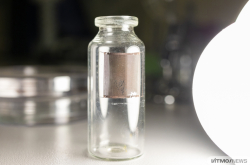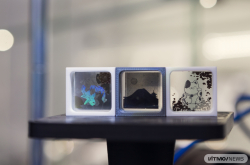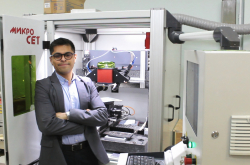The color metal marking laser
The color metal marking is one of applications of a fiber optical laser. The technology is based on interference in oxide film of a metal when its' surface is covered with a colored film. The laser makes it possible to heat the metal in certain points and produce the film locally. It is resulted in making colorful images. The main point is that the engineers managed to make the development process automated, a device switched on by pushing a button colors the surface.
"The technology can be used for developing souvenir products, jewelry and so forth. Furthermore, it helps protect products from garbling. Color marking is also used for branding," notes Galina Odintsova, ColorIT`s head.
A laser cleaning device

A cleaning provided by a fiber optics laser is applied in several fields like cultural heritage items and high cost objects preservation. For instance, one of the first experiments made by the researchers at the Department of Laser Technologies and Systems was related to laser cleaning of radioactive details. By using a laser, it can be conducted remotely, as laser radiation is transported by an optical fiber. This technology can be used for peeling paint layers of nuclear power plant objects, for atomic submarine recycling and other operations on radioactive objects. Furthermore, a smart laser cleaning technology can be applied to renovation purposes.
"The most important thing is that we can control the cleaning process by analyzing the spectrum of laser evaporation. The other advantage of laser cleaning is that it doesn’t require consumable materials, as the equipment can work about 50 thousand hours without a pause," noted Andrey Samokhvalov, the developer of the technology.
ITMO University experts founded a small innovative enterprise "Laser," which uses these methods for providing laser cleaning of anilox rolls used in typography, escalator mechanisms and car engine’s details.

A device for modifying the surface of titanium implants
Using laser patterning of titanium implant surface gives an opportunity to make this material biocompatible. It requires a certain relief of the material’s surface at micro- and nano levels as well as a specific chemical composition.
"Currently we run experiments. For example, we put cells on modified surfaces and analyze how they survive. These experiments are necessary for development of high-quality and safe dental, bone and other implants," commented on Galina Odintsova.
A device for surface patterning of engineering materials
The device is used for property changing of materials applied to different industrial fields. One of examples of surface modification is increasing of paint materials' durability. The higher adhesion colors have the longer they stay bright and stable.

"We can change the structure and composition of a surface automatically by using a program. However, sometimes developers and customers don’t understand what properties they need. That is why we like other researchers collaborate with, for instance, medical experts so as to know how artificial and biomaterials can be compatible. We also make contacts with industrial engineers in order to understand how to develop surfaces with special friction regimes," mentioned Vadim Veiko, head ot the the Department of Laser Technologies and Systems.
A system combining various laser radiation sources
As of now, laser technologies are applied to materials' microprocessing as well as cutting, welding and hardening of large details. However, one faces a problem when dealing with materials that have various physical-chemical properties. Here, several devices can be used, but this makes the production more expensive.

"It would be more convenient to use a multi-task device so as to work with various laser light sources. Such a device can combine light from five, four, three or two lasers into one optical channel. The most important thing is that it can be used for wide range of purposes," nots Maxim Sergeev, the technology’s developer.
These projects give an opportunity to develop and implement promising laser technologies and contribute to educational facilities of the University.




